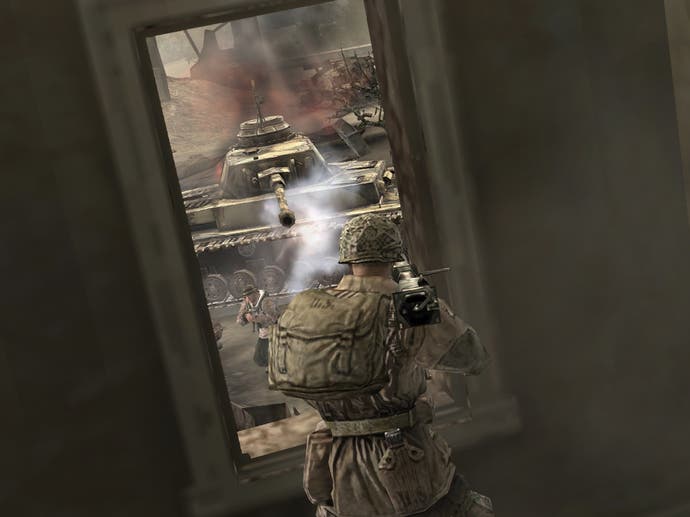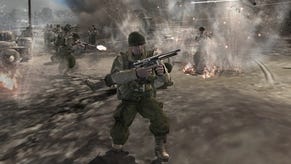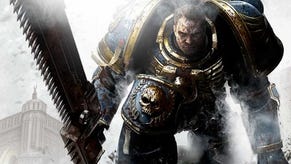Company of Heroes
In the Company of Ico, Deus Ex...
The initial reference point has to be to Knights of the Old Republic.
Before Bioware's role-playing game arrived, anybody who didn't sleep in Yoda pajamas was thoroughly sick with all things Star Wars. Between a string of uninspiring-at-best games and a couple of dreadful films, the galaxy that was a long, long way away wasn't long enough away for most. Then KOTOR appeared with a lot of style and even more vision and made everyone like all this lightsabre nonsense again, unreservedly. The universe had its romance renewed.
For the last half-decade, World War 2 has been similarly run into the ground. The grand conflict between the allied and axis powers is, in videogame terms, the biggest single licence that isn't actually a real licence. Make a WW2 game, and you've got an inbuilt audience, background, world-class character designs, interesting situations and probably the best villains the world has ever seen. But because anyone can make a game set in WW2... everybody did. It's got to the point where we feel as if we've done it all before. How many times have we crawled up the shingles of Omaha beach? If you added up all my virtual deaths in those bloody shallows, it's entirely possible that I've lost more lives than were lost in the real assault. Turn to the comments thread in any World War 2 game preview, and you'll see a string of people shrugging. Bored now! Bored now! Seen this before! What's next?
To make a WW2 game that matters, you need to make something special enough to cut through that armour of cynicism.
Company of Heroes: something special.
At first glance it's a standard RTS... actually, scratch that. "At first glance" Company of Heroes is immediately special. It's more that on paper Company of Heroes sounds like a standard RTS. A string of single-player missions. Skirmish mode against the computer (with co-op partners too). Online multiplayer. Opposing sides with differentiated forces. The usual. In fact, since Company of Heroes only has two separate sides instead of the genre-standard three, on paper it could be taken even as inferior.
"Inferior". That's the last time you'll see that word here.
Company of Heroes is inferior to nobody.

For a start, while it limits its format to the genre basics, it does them as well or better as anyone else. The Skirmish AI is agreeably vicious, for a start. While many of the bigger RTS this year - Rise of Legends, and Battle for Middle Earth in War of the Ring mode, come swiftly to mind - have attempted to step aside from the "linear string of missions grouped around a story" traditional model, Company of Heroes single-player campaign sticks close to it. There's a little addition in having secondary medals you can earn through better performance, and carry your surviving veteran troops onwards to give you an edge, but primarily it's dealing with tasks with a relatively small fraction of the total tools. Essentially, it acts like a slow introduction to the various unit types in the games, making sure you grasp the idiosyncrasies of each one, and putting them together in interesting combinations. It enlivens things in terms of presentation - the in-engine cut-scenes panning out seamlessly to the normal-camera view is immediately engaging and with pretty much perfect pacing.
But it's in the absolute fundamentals where Company of Hero takes the expected and pushes it into the realms of the extraordinary. Not since Total War have we seen a primarily mainstream strategy game decide to base its mechanics so firmly on real life. Most RTS still base themselves on the idea that attacking an opponent will reduce their health by a certain amount, simply modified depending on whether their unit is a counter to the other. In most, troops with swords can still hack down castles. Company of Heroes takes a more naturalistic approach, which makes things more dramatic, compelling and... well, tactical.
Take the machine-guns as an example. A machine-gun, when it opens up at a group of soldiers isn't just a thing which reduces their health bar. A group under machine gun fire is in clear mortal danger. Company of Heroes picks up where Relic's previous Dawn of War left off with its morale system, but extends its effects. Different weapons will cause a unit to become suppressed at different rates, where they'll be forced to fall to the floor and take cover. If fire is maintained, they'll become pinned, where they're unable to return fire and will just cower taking and be wiped out swiftly unless fire is removed (i.e. someone rescues them or the enemy pull back) or they're ordered to retreat (a command which makes the unit in question leg it all the way back to the base). In Company of Heroes, a machine-gun is a weapon which suppresses large groups of incoming troops very quickly. Charging up to a machine-gun position with troops isn't even an option. Almost all troop types are going to revolt if you try it, ending up falling to the ground. Immediately, machine-guns have a specific tactical use which you'll bring to bear according to your tactical needs. Put a machine-gun here and there's absolutely no way anyone on foot is going to come from that direction.

(Of course, machine-guns are entirely useless when applied against a heavy tank. Though it's telling that unlike many other games where a unit can't harm another one, it doesn't stop the machine-guns from firing at it. That they'll open up when it's hopeless is just one of a Company of Heroes many great atmosphere maintaining touches.)
You may have missed something implicit in that paragraph. "That direction". When you set up a machine gun unit, you say which direction you want them to face, which leads to a specific cone they're able to fire at. If something's out of the area, they'll have a delay as they take apart their gun, turn around, and reassemble it. So if you find yourself facing a machine-gun unit as foot soldiers, you'll looking at the terrain and working out if there's any way you can flank it. Or maybe there's enough cover to get near enough to lob a grenade over to clear it...
And that's just the interactions between a couple of unit types. It's both completely naturalistic (so instantly understandable), detailed (the simple process of deciding which way your machine-gun's going to point feels so right) and tactically compelling (the mechanics immediately make the gamer decide what they're doing next). It also shows how Company of Heroes balances the competing desires of units to be self-sufficient while including satisfying ways to interact (i.e. micromanage) them. In this case, when in position, if positioned securely, you can just forget about the machine-gun. They'll deal with anything that comes their way. However, the specifics of what area they're to defend is entirely up to you.









